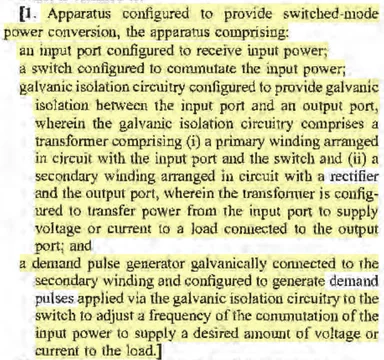
Judge Connolly granted summary judgment of invalidity this week, finding three claims indefinite due to their physical impossibility.
The patent relates to a faster air-powered nail gun, which uses a trigger to control the gun by providing "fluid communication"—i.e., air flow—between air valves.
All of the patent's claims involve triggers and "fluid communication" of various sorts, but defendants picked up on some weird phrasing in one independent claim:
a trigger valve exterior frame to which the main valve control channel is fluidly connected;
Defendants argued that the "exterior frame" is solid and can't be "fluidly connected" to the trigger.
Plaintiffs disagreed, arguing that a person of skill in the art would understand that the patent didn't really mean that the trigger valve was "fluidly connected" to the "frame," but was instead connected to a different component.
Judge Connolly wasn't having it, and held the parties strictly to the language of the claim:
The clear and unambiguous language of claim 2 (from which claims 3 and 4 depend) requires the impossible—"a trigger valve exterior frame to which the main valve control channel is fluidly connected." . . . A trigger valve exterior frame is indisputably a solid. A solid is not a fluid and therefore cannot be fluidly connected to anything. . . .
He found plaintiff's interpretation plausible, but rejected the idea that the Court could re-write the language to save the claim (and the related dependent claims):
[Plaintiff's expert] opinion does not save the claims from Kyocera's indefiniteness challenge for two reasons. First, Dr. Vallee does not say that the frame and channel are fluidly connected, but rather that they are connected such that fluid can pass between the trigger valve and the main control valve channel. (Since the trigger valve and main control valve channel are directly adjacent to one another, Dr. Vallee presumably means by his use of" between" that the fluid passes from the channel into the trigger valve and vice versa.) Second, there is no explanation . . . about how the trigger valve's exterior frame, which is indisputably solid, can be fluidly connected to fluid coming from the channel into the valve or moving from the valve into the channel. Paragraph 307 could plausibly be read to mean that a fluid connection exists between the trigger valve (which consists in part of a hallow area within the exterior frame) and main control valve channel, but it is improper to rewrite claim language to save a patent from impossibility.
Defendant's counsel here did a good job of picking out a small piece of the claim and nailing (ahem) plaintiff with it, taking care of three of the four asserted claims. This comes after they won a rare reversal on reconsideration last month.
If you enjoyed this post, consider subscribing to receive free e-mail updates about new posts.




